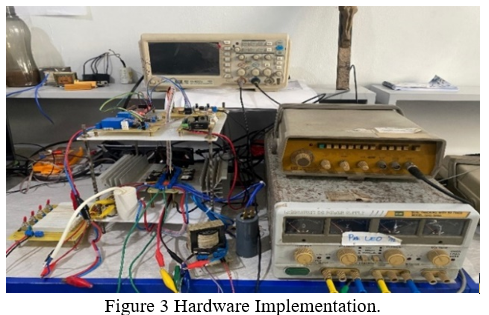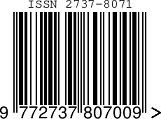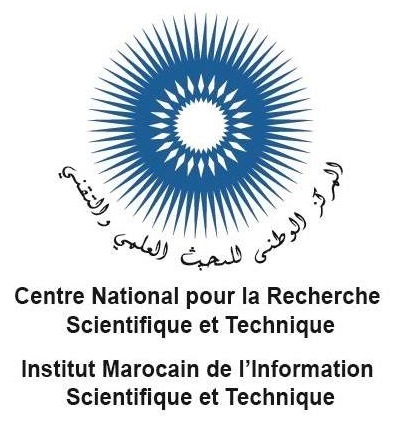Controlling of ZETA Full Bridge Inverter Buck - Boost Output Voltage
Keywords:
ZETA Converter, Full - Bridge Inverter, Solar Panel, Buck - Boost, Voltage ControlAbstract
The development of science and electronics is increasing rapidly, marked by the development and use of renewable energy, such as electric vehicles and solar panels. A good power converter is needed to maintain its practical service life. Renewable energy systems with DC output voltage generally require a DC-DC converter to increase or decrease the voltage level and an inverter to convert the DC voltage to AC. A ZETA Inverter, which combines a ZETA Converter with a Full Bridge Inverter, is proposed in this research. ZETA Converter can increase and decrease the output voltage as needed. The output voltage setting is also applied to the ZETA Inverter topology, using the Voltage Transducer LV25-P as the output voltage detector. The sensor reading results are then compared with the desired reference and then controlled using Proportional Integral (PI) Control, producing a pulse width modulated signal as a switching control on the power switch. Thus, the output voltage can be regulated according to needs. Simulation testing using Power Simulator (PSIM) software is carried out first and then validated by hardware testing in the laboratory. The final result was that the ZETA Inverter output voltage could adjust the reference voltage to increase and decrease voltage conditions. Under changing load conditions, the output voltage remains at the reference value. The defect (THD) level at the output voltage was 1.2%, which meets the IEEE 519 standard, below 5%. Thus, the ZETA Inverter can be a good power converter in renewable energy systems.
Downloads
References
I. Mahmudi, Jumiyatun, B. Mukhlis, and Lukman, “PERANCANGAN ZETA CONVERTER PADA PELACAKAN TITIK DAYA MAKSIMUM PHOTOVOLTAIC MENGGUNAKAN ALGORITMA MODIFIKASI HILL CLIMBING,” J. Ilm. Foristek, vol. 11, no. 1, pp. 41–47, 2021.
E. Amelia Widyastuti, R. Riantiarna, W. Kurniawati, and U. PGRI Yogyakarta, “Efektivitas Panel Surya Sebagai Cadangan Pengganti Energi Listrik Skala Rumahan,” J. Ilmu Tek., vol. 1, no. 2, pp. 256–260, 2024, [Online]. Available: https://doi.org/10.62017/tektonik
E. L. N. Y. N. Carlo, Aldo Di, “Photovoltaics,” EPJ Web Conf., vol. 00005, pp. 1–32, 2020, doi: 10.1051/epjconf/202024600005.
J. Xue, “Photovoltaic agriculture - New opportunity for photovoltaic applications in China,” Renew. Sustain. Energy Rev., vol. 73, no. December 2015, pp. 1–9, 2017, doi: 10.1016/j.rser.2017.01.098.
U. U. . H. Rahman, H. . M.; Ghani, U.; Usman, M.; Ullah, and A. Khan, A.; El-Metwaly, N.M.; Khan, “A Photovoltaic Technology Review: History, Fundamentals and Applications,” Energies, vol. 27, no. 1, p. 4909, 2022.
D. Ardiyanti, F. Kurniawan, U. Raokter, and R. Wikansari, “Analisis Penjualan Mobil Listrik Di Indonesia Dalam Rentang Waktu 2020-2023,” ECOMA J. Econ. Manag., vol. 1, no. 3, pp. 114–122, 2023, doi: 10.55681/ecoma.v1i3.26.
I. Veza et al., “Electric Vehicles in Malaysia and Indonesia: Opportunities and Challenges,” Energies, vol. 15, no. 7, pp. 1–24, 2022, doi: 10.3390/en15072564.
J. A. Sanguesa, V. Torres-Sanz, P. Garrido, F. J. Martinez, and J. M. Marquez-Barja, “A review on electric vehicles: Technologies and challenges,” Smart Cities, vol. 4, no. 1, pp. 372–404, 2021, doi: 10.3390/smartcities4010022.
Z. Li, A. Khajepour, and J. Song, “A comprehensive review of the key technologies for pure electric vehicles,” Energy, vol. 182, pp. 824–839, 2019, doi: 10.1016/j.energy.2019.06.077.
I. Husain et al., “Electric Drive Technology Trends, Challenges, and Opportunities for Future Electric Vehicles,” Proc. IEEE, vol. 109, no. 6, pp. 1039–1059, 2021, doi: 10.1109/JPROC.2020.3046112.
S. Kharjule, “Voltage Source Inverter,” Int. Conf. Energy Syst. Appl. (ICESA 2015), no. Icesa, 2015.
A. K. Koshti and M. N. Rao, “A brief review on multilevel inverter topologies,” 2017 Int. Conf. Data Manag. Anal. Innov. ICDMAI 2017, pp. 187–193, 2017, doi: 10.1109/ICDMAI.2017.8073508.
D. Pattabiraman, R. H. Lasseter, and T. M. Jahns, “Comparison of Grid Following and Grid Forming Control for a High Inverter Penetration Power System,” IEEE Power Energy Soc. Gen. Meet., vol. 2018-Augus, pp. 3–7, 2018, doi: 10.1109/PESGM.2018.8586162.
A. Trzynadlowski, Modern Power Electronics, vol. 18, no. 7. 2005. doi: 10.1109/mper.1998.686953.
L. H. Pratomo, S. Paudel, and B. K. Cahyadi, “A simple method for controlling buck-boost SEPIC-H bridge inverter,” Int. J. Appl. Power Eng., vol. 13, no. 3, pp. 670–678, 2024, doi: 10.11591/ijape.v13.i3.pp670-678.
S. Maheshri and P. Khampariya, “Simulation of single phase SPWM ( Unipolar ) inverter,” Int. J. Innov. Res. Adv. Eng., vol. 1, no. 9, pp. 12–18, 2014.
S. Oommen et al., “Zeta Converter Simulation for Continuos Current Mode Operation,” Int. J. Adv. Res. Eng. Technol., vol. 10, no. 1, pp. 243–248, 2019.
M. R. Banaei and H. A. F. Bonab, “A High Efficiency Nonisolated Buck-Boost Converter Based on ZETA Converter,” IEEE Trans. Ind. Electron., vol. 67, no. 3, pp. 1991–1998, 2020, doi: 10.1109/TIE.2019.2902785.
A. A. Dionizio, G. M. Pelz, L. P. Sampaio, and S. A. O. da Silva, “Novel Integrated Zeta Inverter for Standalone Applications,” Energies , vol. 17, no. 11, 2024, doi: 10.3390/en17112748.
A. P. Nandiwardhana, H. Suryoatmojo, and M. Ashari, “Perancangan Zeta Converter yang dilengkapi Power Factor Correction pada Aplikasi Pengaturan Kecepatan Motor Brushless DC,” J. Tek. ITS, vol. 5, no. 2, 2016, doi: 10.12962/j23373539.v5i2.16099.
X. Weng et al., “Comprehensive comparison and analysis of non?inverting buck boost and conventional buck boost converters,” J. Eng., vol. 2019, no. 16, pp. 3030–3034, 2019, doi: 10.1049/joe.2018.8373.
N. Zhang, S. Batternally, K. C. Lim, K. W. See, and F. Han, “Analysis of the non-inverting buck-boost converter with four-mode control method,” Proc. IECON 2017 - 43rd Annu. Conf. IEEE Ind. Electron. Soc., vol. 2017-Janua, pp. 876–881, 2017, doi: 10.1109/IECON.2017.8216151.
X. E. Hong, J. F. Wu, and C. L. Wei, “98.1%-Efficiency Hysteretic-Current-Mode Noninverting Buck-Boost DC-DC Converter With Smooth Mode Transition,” IEEE Trans. Power Electron., vol. 32, no. 3, pp. 2008–2017, 2017, doi: 10.1109/TPEL.2016.2567484.
H. Sun et al., “Review of Challenges and Research Opportunities for Voltage Control in Smart Grids,” IEEE Trans. Power Syst., vol. 34, no. 4, pp. 2790–2801, 2019, doi: 10.1109/TPWRS.2019.2897948.
J. O. Petinrin and M. Shaabanb, “Impact of renewable generation on voltage control in distribution systems,” Renew. Sustain. Energy Rev., vol. 65, pp. 770–783, 2016, doi: 10.1016/j.rser.2016.06.073.
G. Singh and V. K. Garg, “THD analysis of cascaded H-bridge multi-level inverter,” 4th IEEE Int. Conf. Signal Process. Comput. Control. ISPCC 2017, vol. 2017-Janua, pp. 229–234, 2017, doi: 10.1109/ISPCC.2017.8269680.

Downloads
Published
How to Cite
Issue
Section
License
Copyright (c) 2025 Wisely Richard Arthur, Leonardus Heru Pratomo

This work is licensed under a Creative Commons Attribution 4.0 International License.
Copyright on any article in the International Journal of Engineering and Applied Physics is retained by the author(s) under the Creative Commons license, which permits unrestricted use, distribution, and reproduction provided the original work is properly cited.
License agreement
Authors grant IJEAP a license to publish the article and identify IJEAP as the original publisher.
Authors also grant any third party the right to use, distribute and reproduce the article in any medium, provided the original work is properly cited.














